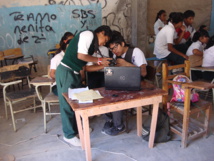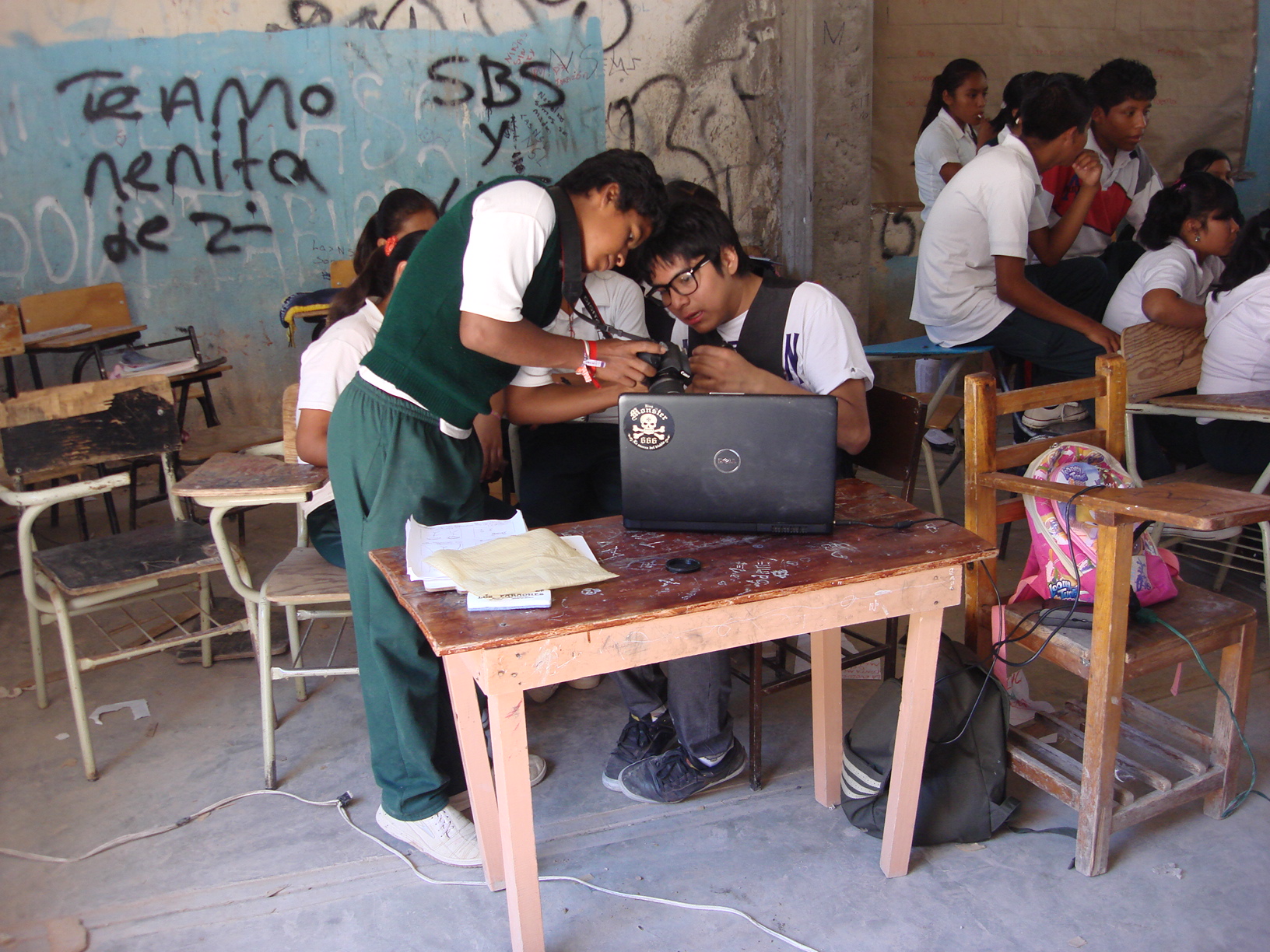
Teenagers of secondary education with cameras and computers in the city of Tlapa de Comonfort (Guerrero, Mexico). Photo: Luz Lazos. Source: DICyT.
Various Mexican indigenous communities are testing a new operating system based on free software to adapt it to their languages, cultures and needs. It is the Heliox Project, based on GNU/Linux. This project has been created to make technological advances available to more people.
Originally, Heliox OS was thought to improve the accessibility for disabled people within a project of the Superior Council for Scientific Research (CSIC).
Later, the project was presented in Mexico and gained a new perspective. “We were asked if a part from dealing with functional diversity, we could do something with cultural diversity of indigenous people, and we started to work”, says Roberto Feltrero, PhD in Cognitive Science by the UNED and director of the project”. The National Autonomous University of Mexico (UNAM), biggest university of Latin American, participated in the project, which received founding from the Indigenous Language Institute.
In Mexico there are 360 languages, and doing just a translation is an enormous work, so the way of proceeding must change. Indigenous communities should be able to handle their technological development”. That is to say, instead of commercialising a closed product, as many companies do, users are able to develop their own system adapted to their language and culture just using a given base.
Moreover, the idea of translating is nonsense when most of the terms, such as “open file” or “save as”, do not have equivalent in any indigenous language. The same happens with the icons, which do not mean anything to someone who has never used a computer, so expressions like “use this tool to edit video” or “for surfing on the Internet”.
Although the proposal is that indigenous people develop a great part of the software, specialists are not necessary. “Modifying your system does not implies being programmer, but having the tools to make it work as you want, and we have been doing this during 20 years with computers, mobile phones, and tablets when we choose which applications we want to install or how configure our desktop”, ensures Feltrero.
That is why we offer something simple but adaptable, where everyone can designed and introduce new icons, decide commands, or record voices. Everyone will have access to this technology through an initial training, without being an expert.
Another relevant aspect is that the system has to be run in old computers, because the access to technology is limited. In this sense, the base of Heliox OS is simple and can operate even without being installed in the computer, just using an USB.
“The cost is very slight compared with other commercial alternatives”, say León Olivé and Luz Lazos, researchers of the Seminar Society of Knowledge and Cultural Diversity of the Institute of Philosophic Researches of the UNAM.
Mexican researches work on this and other projects with Purépechas communities (state of Michoacán), Mephaa, Nahuatl, Mixteco (state of Guerrero), Mixe (state of Oaxaca), and Maya (estate of Yucatán). Heliox is now being developed in three languages: Nahuatl, Maya, and Mixe.
Status
“Technology and Access to it are seen as symbols of status and progress”, says Yasnaya Elena Aguilar, a Mixe who works as a linguists and translator in the Juan de Córdova Library in Oaxaca, apart from coordinate the Committee of Higher Education of the Mixe community of Ayutla, also located in Oaxaca.
In her opinion, “the linguistic rights of speakers of indigenous people continue to be violated, therefore, to a greater or lesser extent, all languages and cultures are under threat.” However, “there are increasing community initiatives that are working in the recovery of knowledge, strengthening projects and linguistic resistance.”
Experts coincide in the existence of a digital divide between indigenous people and the rest of the Mexican population, although it has to be with the urban or rural character of the communities, since urban citizens have more access. That is why, language may be the factor that makes the difference to the little presence of indigenous languages in the web and in new technologies.
Originally, Heliox OS was thought to improve the accessibility for disabled people within a project of the Superior Council for Scientific Research (CSIC).
Later, the project was presented in Mexico and gained a new perspective. “We were asked if a part from dealing with functional diversity, we could do something with cultural diversity of indigenous people, and we started to work”, says Roberto Feltrero, PhD in Cognitive Science by the UNED and director of the project”. The National Autonomous University of Mexico (UNAM), biggest university of Latin American, participated in the project, which received founding from the Indigenous Language Institute.
In Mexico there are 360 languages, and doing just a translation is an enormous work, so the way of proceeding must change. Indigenous communities should be able to handle their technological development”. That is to say, instead of commercialising a closed product, as many companies do, users are able to develop their own system adapted to their language and culture just using a given base.
Moreover, the idea of translating is nonsense when most of the terms, such as “open file” or “save as”, do not have equivalent in any indigenous language. The same happens with the icons, which do not mean anything to someone who has never used a computer, so expressions like “use this tool to edit video” or “for surfing on the Internet”.
Although the proposal is that indigenous people develop a great part of the software, specialists are not necessary. “Modifying your system does not implies being programmer, but having the tools to make it work as you want, and we have been doing this during 20 years with computers, mobile phones, and tablets when we choose which applications we want to install or how configure our desktop”, ensures Feltrero.
That is why we offer something simple but adaptable, where everyone can designed and introduce new icons, decide commands, or record voices. Everyone will have access to this technology through an initial training, without being an expert.
Another relevant aspect is that the system has to be run in old computers, because the access to technology is limited. In this sense, the base of Heliox OS is simple and can operate even without being installed in the computer, just using an USB.
“The cost is very slight compared with other commercial alternatives”, say León Olivé and Luz Lazos, researchers of the Seminar Society of Knowledge and Cultural Diversity of the Institute of Philosophic Researches of the UNAM.
Mexican researches work on this and other projects with Purépechas communities (state of Michoacán), Mephaa, Nahuatl, Mixteco (state of Guerrero), Mixe (state of Oaxaca), and Maya (estate of Yucatán). Heliox is now being developed in three languages: Nahuatl, Maya, and Mixe.
Status
“Technology and Access to it are seen as symbols of status and progress”, says Yasnaya Elena Aguilar, a Mixe who works as a linguists and translator in the Juan de Córdova Library in Oaxaca, apart from coordinate the Committee of Higher Education of the Mixe community of Ayutla, also located in Oaxaca.
In her opinion, “the linguistic rights of speakers of indigenous people continue to be violated, therefore, to a greater or lesser extent, all languages and cultures are under threat.” However, “there are increasing community initiatives that are working in the recovery of knowledge, strengthening projects and linguistic resistance.”
Experts coincide in the existence of a digital divide between indigenous people and the rest of the Mexican population, although it has to be with the urban or rural character of the communities, since urban citizens have more access. That is why, language may be the factor that makes the difference to the little presence of indigenous languages in the web and in new technologies.


 English
English



